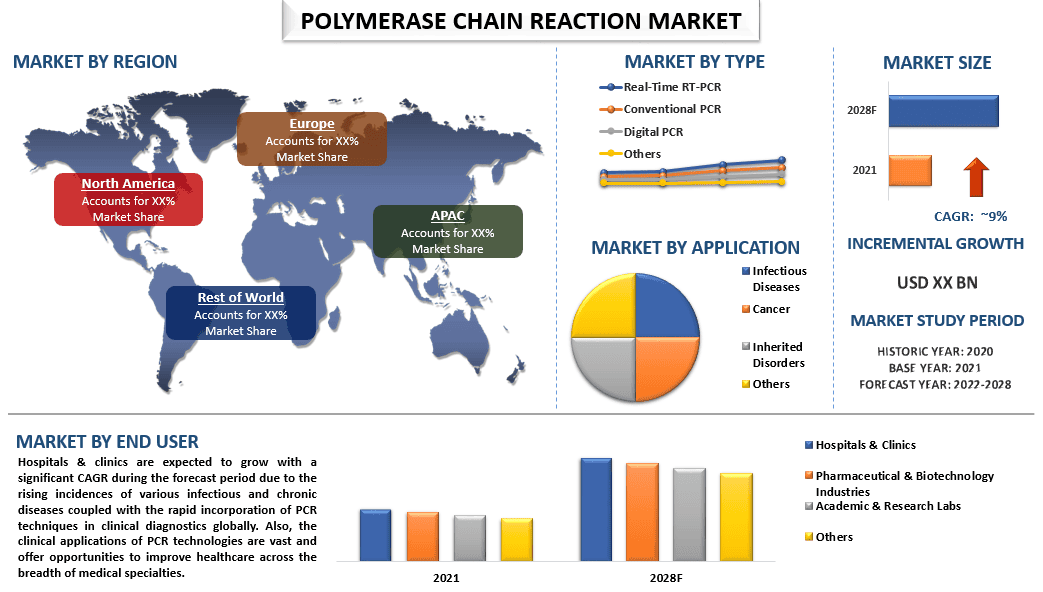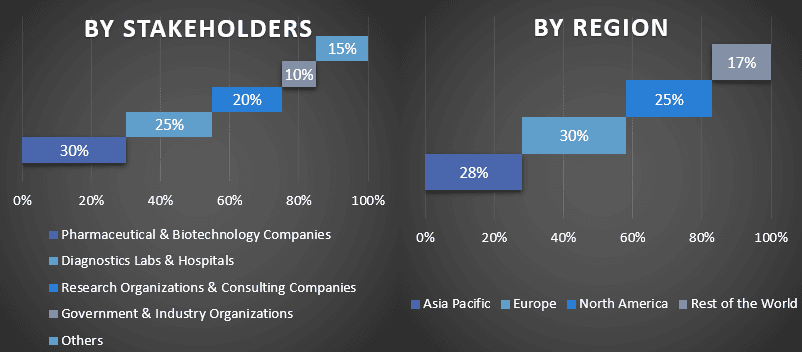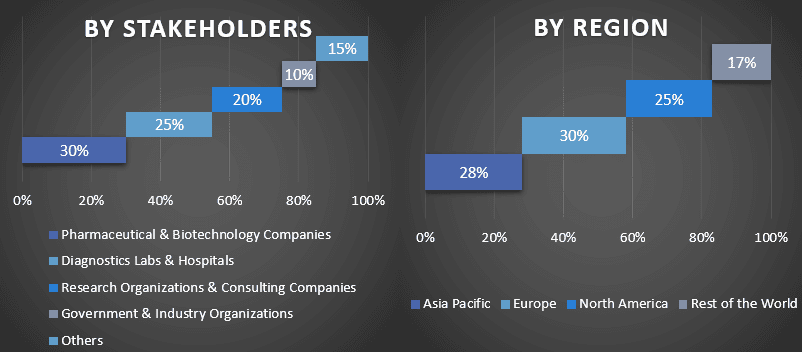Emphasis on Type (Real-Time RT-PCR, Conventional PCR, Digital PCR, Others); By Application (Infectious Diseases, Cancer, Inherited Disorders, And Others); By End-User (Hospitals & Clinics, Pharmaceutical & Biotechnology Industries, Academic & Research Labs, Others); and Region/Country

Global Polymerase Chain Reaction Market is expected to grow at a significant rate of around 9% during the forecast period. PCR stands for a polymerase chain reaction which is a molecular diagnostic technique that detects genetic material from a specific organism such as a virus. PCR technology is used to generate millions of copies of a piece of DNA. These techniques are commonly used in various life science fields such as genetics, molecular biology research, and clinical diagnostics. The global polymerase chain reaction market is anticipated to witness an uptick with the growing focus on genome research and rising government funding for conducting gene-based research across the world. For instance, in Ireland, Genomics Medicine Ireland (GMI) received funding of USD 413.91 million for conducting genome-related research in 2018 enabling scientists to expand their research to over 60 areas of diseases. Furthermore, with the widespread expansion of the coronavirus, there is a surge in demand for an effective and accurate molecular diagnostics technique including PCR. Thus, key players are launching new and innovative PCR kits for affordable and accurate diagnosis of COVID-19. For instance, in 2020, Equine Biotech, an IISC startup, developed an indigenous RT-PCR diagnostic kit called “GlobalTM diagnostic kit“. The test takes about 1.5 hours to confirm the presence of SARS-CoV-2 in patient samples.
Thermo Fisher Scientific Inc., Bio-Rad Laboratories Inc., QIAGEN, Agilent Technologies Inc., Standard Biotools, F. Hoffmann-La Roche Ltd., Merck & Co. Inc., Abbott, Promega Corporation, Takara Bio Inc. are some of the key players in the market. Several M&As along with partnerships have been undertaken by these players to facilitate customers with hi-tech and innovative products/technologies.
Insights Presented in the Report
“Amongst type, real-time PCR segment held a significant market share in 2021”
Based on type, the polymerase chain reaction market is segmented into real-time RT-PCR, conventional PCR, digital PCR, and others. The real-time PCR segment held a significant market share in 2021. This is mainly due to the commonly used gene expression and DNA or RNA in a sample. Also, the use of real-time RT-PCR to identify the existence of SARS-CoV during the COVID-19 pandemic prompted the growth of the RT-PCR market. For instance, in March 2020, the COVID-19 genomics U.K. consortium (COG-U.K.) was performed to study the coronavirus genome by using whole-genome sequencing.
“Amongst application, the infectious diseases are expected to grow with a significant CAGR during the forecast period”
Based on application, the polymerase chain reaction market is segmented into infectious diseases, cancer, inherited disorders, and others. Infectious diseases are expected to grow with a significant CAGR during the forecast period. This is mainly due to an increase in the prevalence of infectious diseases. As per the article of BMC Infectious Diseases, in 2022, in total, 106,289 cases of 130 infectious diseases were diagnosed among the population, with an incidence density (ID) of 694.86 per 100,000 person-years.
“North America held a significant share in the market”
In 202, North America held a significant share of the global polymerase chain reaction market. This is mainly attributed to the increasing cancer incidence and higher government-funded initiatives. For instance, as per the GLOBOCON 2020, 22,81,658 new cancer cases and 6,12,390 deaths were reported in the U.S. The major factors such as favorable government initiatives, increasing public-private investments in the field of cancer microbiome sequencing, and the rising cancer incidences in the region. For instance, in America, nearly 1.9 million new cancer cases were expected to be diagnosed in 2021. Approximately 608,570 Americans are expected to die of cancer in 2021, which translates to about 1,670 deaths per day. This has attracted the focus of many biotechnology companies on developing cancer microbiome sequencing solutions for different applications such as translational research and diagnostics which will further support the researchers and clinicians to unravel insights pertaining to the microbiome’s influence on cancer manifestation and progression.
Reasons to buy this report:
Customization Options:
The global Polymerase Chain Reaction market can further be customized as per the requirement or any other market segment. Besides this, UMI understands that you may have your own business needs, hence feel free to connect with us to get a report that completely suits your requirements.
1. Market Introduction
2. Research Methodology Or Assumption
3. Market Synopsis
4. Executive Summary
5. Impact Of Covid-19 On The Polymerase Chain Reaction Market
6. Polymerase Chain Reaction Market Revenue (usd Bn), 2020-2028f
7. Market Insights By Type
8. Market Insights By Application
9. Market Insights By End User
10. Market Insights By Region
11. Polymerase Chain Reaction Market Dynamics
12. Polymerase Chain Reaction Market Opportunities
13. Polymerase Chain Reaction Market Trends
14. Demand And Supply-side Analysis
15. Value Chain Analysis
16. Pricing Analysis
17. Strategic Insights
18. Competitive Scenario
19. Company Profiled
20. Disclaimer
Research Methodology for the Polymerase Chain Reaction Market Analysis (2022-2028)
Analyzing the historical market, estimating the current market, and forecasting the future market of the global polymerase chain reaction market were the three major steps undertaken to create and analyze the adoption of polymerase chain reactions in major regions globally. Exhaustive secondary research was conducted to collect the historical market numbers and estimate the current market size. Secondly, to validate these insights, numerous findings and assumptions were taken into consideration. Moreover, exhaustive primary interviews were also conducted, with industry experts across the value chain of the global polymerase chain reaction market. Post assumption and validation of market numbers through primary interviews, we employed a top-down/bottom-up approach to forecasting the complete market size. Thereafter, market breakdown and data triangulation methods were adopted to estimate and analyze the market size of segments and sub-segments of the industry pertains to. Detailed methodology is explained below:
Analysis of Historical Market Size
Step 1: In-Depth Study of Secondary Sources:
Detail secondary study was conducted to obtain the historical market size of the polymerase chain reaction market through company internal sources such as annual reports & financial statements, performance presentations, press releases, etc., and external sources including journals, news & articles, government publications, competitor publications, sector reports, third-party database, and other credible publications.
Step 2: Market Segmentation:
After obtaining the historical market size of the polymerase chain reaction market, we conducted a detailed secondary analysis to gather historical market insights and share for different segments & sub-segments for major regions. Major segments are included in the report as type, application, and end user. Further country-level analyses were conducted to evaluate the overall adoption of testing models in that region.
Step 3: Factor Analysis:
After acquiring the historical market size of different segments and sub-segments, we conducted a detailed factor analysis to estimate the current market size of the polymerase chain reaction market. Further, we conducted factor analysis using dependent and independent variables such as various type, application, and end user of polymerase chain reactions. A thorough analysis was conducted for demand and supply-side scenarios considering top partnerships, mergers and acquisitions, business expansion, and product launches in the polymerase chain reaction market sector across the globe.
Current Market Size Estimate & Forecast
Current Market Sizing: Based on actionable insights from the above 3 steps, we arrived at the current market size, key players in the global polymerase chain reaction market, and market shares of the segments. All the required percentage shares split, and market breakdowns were determined using the above-mentioned secondary approach and were verified through primary interviews.
Estimation & Forecasting: For market estimation and forecast, weights were assigned to different factors including drivers & trends, restraints, and opportunities available for the stakeholders. After analyzing these factors, relevant forecasting techniques i.e., the top-down/bottom-up approach were applied to arrive at the market forecast for 2028 for different segments and sub-segments across the major markets globally. The research methodology adopted to estimate the market size encompasses:
Market Size and Share Validation
Primary Research: In-depth interviews were conducted with the Key Opinion Leaders (KOLs) including Top Level Executives (CXO/VPs, Sales Head, Marketing Head, Operational Head, Regional Head, Country Head, etc.) across major regions. Primary research findings were then summarized, and statistical analysis was performed to prove the stated hypothesis. Inputs from primary research were consolidated with secondary findings, hence turning information into actionable insights.
Split of Primary Participants in Different Regions

Market Engineering
The data triangulation technique was employed to complete the overall market estimation and to arrive at precise statistical numbers for each segment and sub-segment of the global polymerase chain reaction market. Data was split into several segments & sub-segments post studying various parameters and trends in the areas of type, application, and end user in the global Polymerase Chain Reaction market.
The main objective of the Global Polymerase Chain Reaction Market Study
The current & future market trends of the global polymerase chain reaction market were pinpointed in the study. Investors can gain strategic insights to base their discretion for investments on the qualitative and quantitative analysis performed in the study. Current and future market trends determined the overall attractiveness of the market at a regional level, providing a platform for the industrial participant to exploit the untapped market to benefit from a first-mover advantage. Other quantitative goals of the studies include:

Customers who bought this item also bought